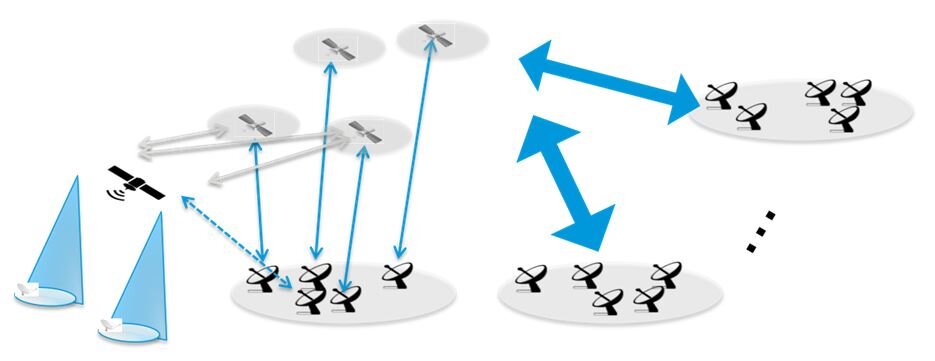Multiple Access Telecom Reconfigurable Intersatellites
| 717 - Abstract: |
| The bandwidth usage of satellite communication systems and therefore the whole satellite communication market is growing. Feeder links are becoming a bottleneck with the emergence of Very High Throughput Satellite systems and, hence, for further exploiting these systems. Suitable satellite gateway locations are scarce and maintaining a high number of gateways to improve the feeder-links leads to high costs. The European Space Agency proposes an invention, which enables the increase of the aggregated capacity on the feeder link beyond one Terabit/s. ESA is looking for partners who would be interested in licensing and implementing this patent. |
Description:
In a classical satellite communication multi-beam system for relaying information between a user terminal and a ground gateway through a satellite repeater, the repeater forms user-link beams and feeder-link beams for communication with the terminals and gateway stations. Re-using the available spectrum several times can lead to a high frequency re-use factor employed on the user link. The enhancements of performance for the feeder link can be insufficient, so that it can become a bottleneck. The state-of-the-art suggests different solutions:
- Using a high number of gateway sites within the user coverage on a portion of the Ka-band spectrum which is not used on the user link
- Using a high number of gateway sites outside the user coverage zone which allows employing the complete Ka-band spectrum for gateway transmission
- Moving to higher frequency band on the feeder link (Q/V or W-band) but still using a significant number of gateway sites
These systems require a complex and expensive ground system with a high number of gateway sites.
The European Space Agency suggests a satellite communication system with split gateway and user link functionalities, as depicted in Figure 1. Therefore, the communication system comprises user and feeder satellites, which communicate via inter-satellite links. The invention makes use of several feeder satellites connected to a limited number of gateway sites with feeder-link beams. The user satellite is in a geostationary orbit and it is adapted to manage multiple user-link beams.
It is possible to operate several feeder satellites simultaneously with sufficient angular separation. This allows a full frequency re-use of the feeder spectrum. Hence, the invention allows a reduction of the number of gateway sites and the associated infrastructure, operation and network expenses.
The invention also enables the increase of the aggregated capacity on the feeder link to several Terabit/s at a fraction of the costs for the state-of-the-art solutions. Moreover, decoupling the user- and feeder-link orbit slot allocation allows to “pay as you grow” by involving more feeder satellites to cope with the user demand, which can increase gradually.
Innovations and advantages:
- Lower overall system costs, lower feeder-link service costs, i.e. the amount of ground stations can be reduced
- Improved frequency utilization
- Easier interference management
- Standardization of feeder satellites and enabling of progressive deployment
- “Pay as you grow” business paradigm serving different applications reducing time to market and risk
Domain of application:
The technology can be used for data relay and, for instance, has the following application domains:
- Earth Observation
- Science
- Communication systems


